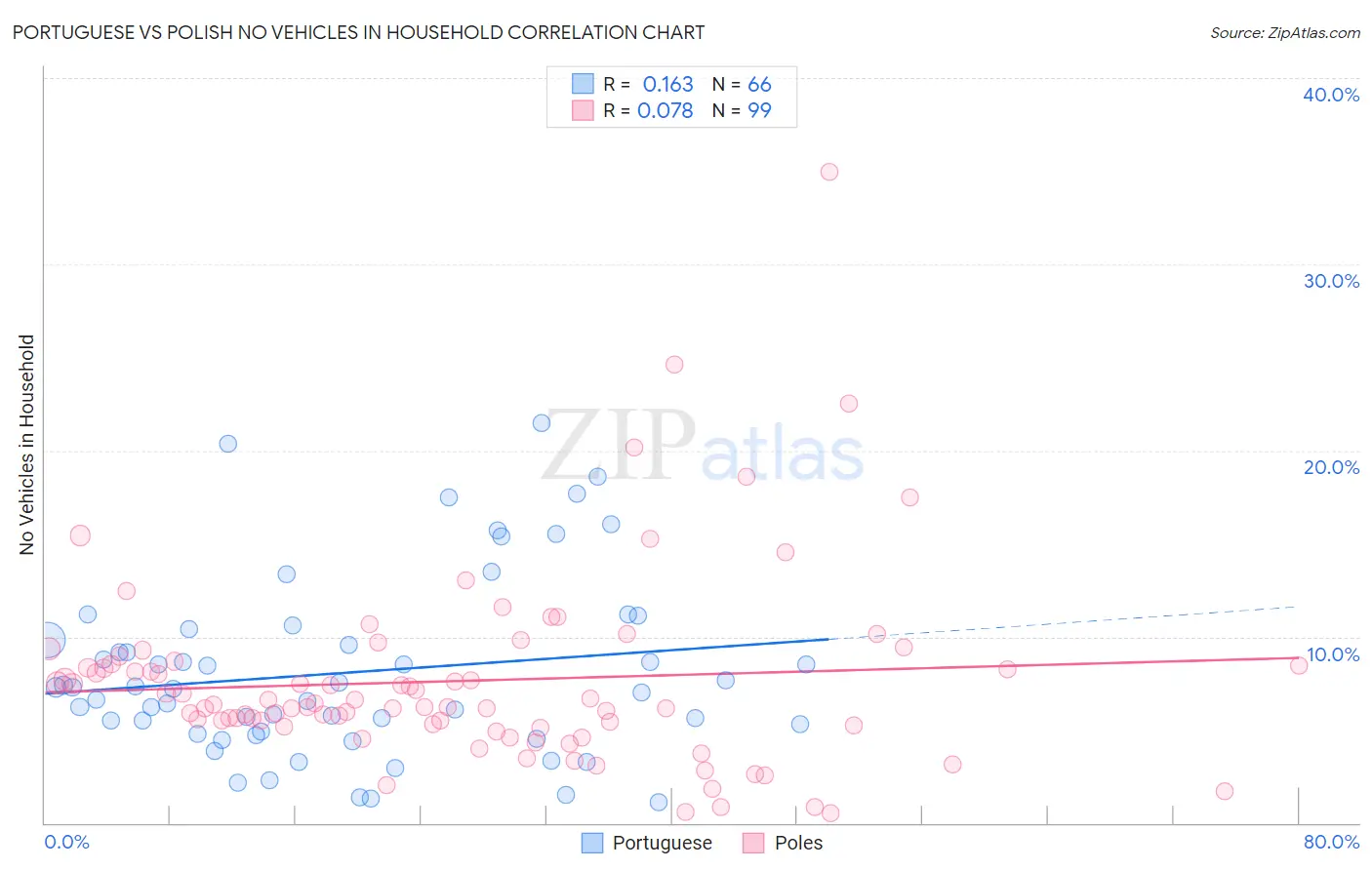Portuguese vs Polish No Vehicles in Household
COMPARE
Portuguese
Polish
No Vehicles in Household
No Vehicles in Household Comparison
Portuguese
Poles
8.6%
NO VEHICLES IN HOUSEHOLD
99.5/ 100
METRIC RATING
79th/ 347
METRIC RANK
8.4%
NO VEHICLES IN HOUSEHOLD
99.6/ 100
METRIC RATING
73rd/ 347
METRIC RANK
Portuguese vs Polish No Vehicles in Household Correlation Chart
The statistical analysis conducted on geographies consisting of 448,384,012 people shows a poor positive correlation between the proportion of Portuguese and percentage of households with no vehicle available in the United States with a correlation coefficient (R) of 0.163 and weighted average of 8.6%. Similarly, the statistical analysis conducted on geographies consisting of 555,400,436 people shows a slight positive correlation between the proportion of Poles and percentage of households with no vehicle available in the United States with a correlation coefficient (R) of 0.078 and weighted average of 8.4%, a difference of 1.6%.

No Vehicles in Household Correlation Summary
| Measurement | Portuguese | Polish |
| Minimum | 1.1% | 0.52% |
| Maximum | 21.5% | 35.0% |
| Range | 20.4% | 34.5% |
| Mean | 8.1% | 7.6% |
| Median | 7.3% | 6.4% |
| Interquartile 25% (IQ1) | 4.9% | 5.3% |
| Interquartile 75% (IQ3) | 9.8% | 8.5% |
| Interquartile Range (IQR) | 4.9% | 3.3% |
| Standard Deviation (Sample) | 4.8% | 5.1% |
| Standard Deviation (Population) | 4.7% | 5.1% |
Demographics Similar to Portuguese and Poles by No Vehicles in Household
In terms of no vehicles in household, the demographic groups most similar to Portuguese are Immigrants from South Central Asia (8.6%, a difference of 0.060%), Bolivian (8.6%, a difference of 0.15%), Iranian (8.6%, a difference of 0.18%), Tsimshian (8.6%, a difference of 0.20%), and Immigrants from Philippines (8.5%, a difference of 0.26%). Similarly, the demographic groups most similar to Poles are Lithuanian (8.4%, a difference of 0.030%), Immigrants from Lebanon (8.4%, a difference of 0.060%), Cajun (8.4%, a difference of 0.090%), Spaniard (8.4%, a difference of 0.81%), and Cuban (8.5%, a difference of 0.86%).
| Demographics | Rating | Rank | No Vehicles in Household |
| Palestinians | 99.7 /100 | #66 | Exceptional 8.3% |
| Immigrants | Scotland | 99.7 /100 | #67 | Exceptional 8.3% |
| Immigrants | Iran | 99.7 /100 | #68 | Exceptional 8.4% |
| Spaniards | 99.7 /100 | #69 | Exceptional 8.4% |
| Cajuns | 99.6 /100 | #70 | Exceptional 8.4% |
| Immigrants | Lebanon | 99.6 /100 | #71 | Exceptional 8.4% |
| Lithuanians | 99.6 /100 | #72 | Exceptional 8.4% |
| Poles | 99.6 /100 | #73 | Exceptional 8.4% |
| Cubans | 99.5 /100 | #74 | Exceptional 8.5% |
| Jordanians | 99.5 /100 | #75 | Exceptional 8.5% |
| Immigrants | Philippines | 99.5 /100 | #76 | Exceptional 8.5% |
| Iranians | 99.5 /100 | #77 | Exceptional 8.6% |
| Immigrants | South Central Asia | 99.5 /100 | #78 | Exceptional 8.6% |
| Portuguese | 99.5 /100 | #79 | Exceptional 8.6% |
| Bolivians | 99.4 /100 | #80 | Exceptional 8.6% |
| Tsimshian | 99.4 /100 | #81 | Exceptional 8.6% |
| Immigrants | South Eastern Asia | 99.4 /100 | #82 | Exceptional 8.6% |
| Italians | 99.4 /100 | #83 | Exceptional 8.6% |
| Immigrants | Jordan | 99.3 /100 | #84 | Exceptional 8.7% |
| Lebanese | 99.3 /100 | #85 | Exceptional 8.7% |
| Bangladeshis | 99.3 /100 | #86 | Exceptional 8.7% |